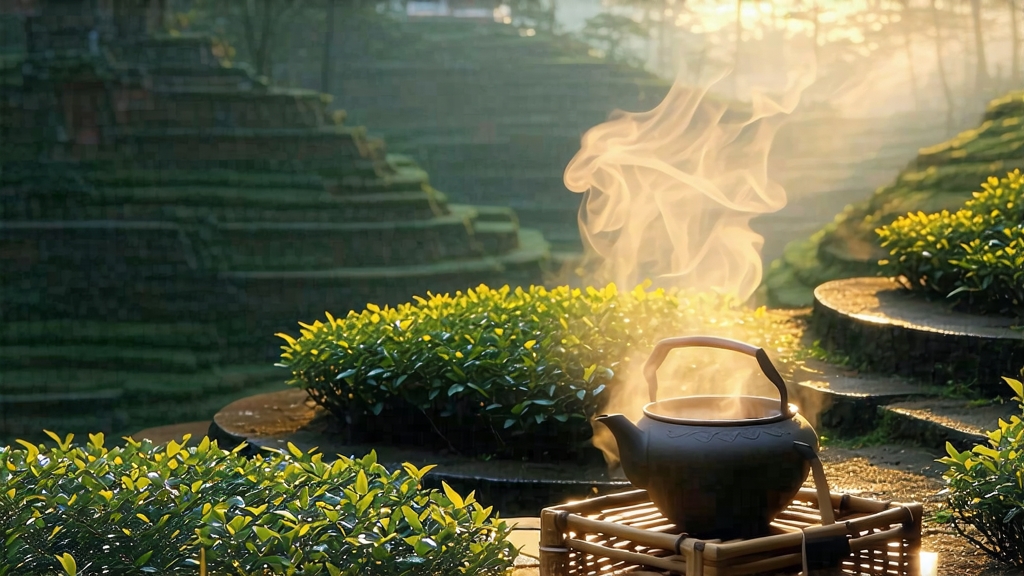
Tucked high on the mist-laden slopes of Mt. Meng in Sichuan province, Meng Ding Huang Ya—“the yellow bud from Meng Summit”—has been whispered about by Chinese tea lovers since the Tang dynasty. Western drinkers often meet green, black or oolong first; yellow tea remains a quiet aristocrat, produced in tiny lots, its flavour poised between the grassy brightness of spring greens and the mellow sweetness of aged white. Among the handful of authentic yellow teas still handmade today, Meng Ding Huang Ya carries the oldest pedigree, yet it is the least exported, making every encounter with it feel like stumbling upon a palace secret.
History: from imperial tribute to near extinction
The first written record appears in 808 CE, when the monk Gan Shi presented “mengding sweet dew” to Emperor Xianzong. By the Song court the tea was taxed in bud-weight rather than coin, and during Ming times caravans carried it across the Tea-Horse Road to Tibet, exchanging one tael of buds for one tael of silver. When Qing emperors moved their spring residence to Chengdu, the tea was carried by runners who changed horses every ten li so that the leaves, plucked at dawn, could steep in the imperial bowl by dusk. The 20th century brought turmoil: civil war disrupted the mountain gardens, and the 1950s collectivisation replaced delicate yellowing sheds with mass-production lines for green tea. Only in 1978 did the state reassemble three surviving craftsmen, now in their seventies, to resurrect the lost choreography of “sealed yellowing.” Today fewer than 300 kg of authentic Meng Ding Huang Ya reach the market each year, most snapped up by collectors in Beijing and Shanghai before a single leaf crosses the Pacific.
Micro-terroir: why the mountain makes yellow possible
Mt. Meng thrusts 1,450 m above the Chengdu plain, trapping the Sichuan basin’s humid clouds against its granite face. Year-round fog filters sunlight into a soft, shifting mosaic, slowing photosynthesis and stacking amino acids—especially L-theanine—in every apical bud. Night temperatures drop 10 °C, locking in floral precursors while keeping cathechin bitterness low. The soil is a friable, quartz-rich yellow loam, acidic (pH 4.8) yet laced with slow-release potassium from feldspar veins. These conditions give the raw leaf a natural sweetness that survives the extra oxidation step that defines yellow tea; without this mountain coolness the same process would flatten into dull hay.
Plucking calendar: one bud, one leaf, one hour
Authentic Meng Ding Huang Ya is made only from the cultivar “Mengding #9,” a local seed-selected bush that awakens three weeks earlier than Fuding white cultivars. The plucking window opens on the first day after Qingming when the morning fog lifts before 9 a.m.—usually 5–12 April. Two rules govern the pick: the bud must still be closed like a grain of rice, and the adjacent first leaf must be shorter than the bud itself. Experienced pickers finish their basket within 60 minutes; after that, stem enzymatic activity rises sharply, complicating the yellowing phase. A full kilogram of finished tea demands 42,000 such sets, the daily yield of six pickers working shoulder-to-shoulder along 45-degree slopes.
Craft: the art of “men huang”—sealed yellowing
Yellow tea is not simply “green tea with a longer kill-green.” It possesses an extra, proprietary step that straddles oxidation and fermentation. The Meng Ding protocol, codified in 1982, unfolds over five days:
- Air withering: baskets of buds rest in shaded draft corridors for three hours, losing 8 % moisture and developing a faint orchid note.
- Hot-kill: wok temperature is held at 140 °C for 90 seconds—just enough to denature polyphenol oxidase at the leaf edge while keeping the bud core enzymatically alive.
- First wrapping: the still-warm leaf is piled 3 cm deep inside muslin squares, then slid into a bamboo steam chamber at 38 °C and 85 % RH for 24 h. During this “sweat” the inner bud oxidises slightly, turning from jade to pale champagne.
- Second kill & re-wrap: the leaf is given a 60-second second wok pass to halt rising oxidation, then wrapped again